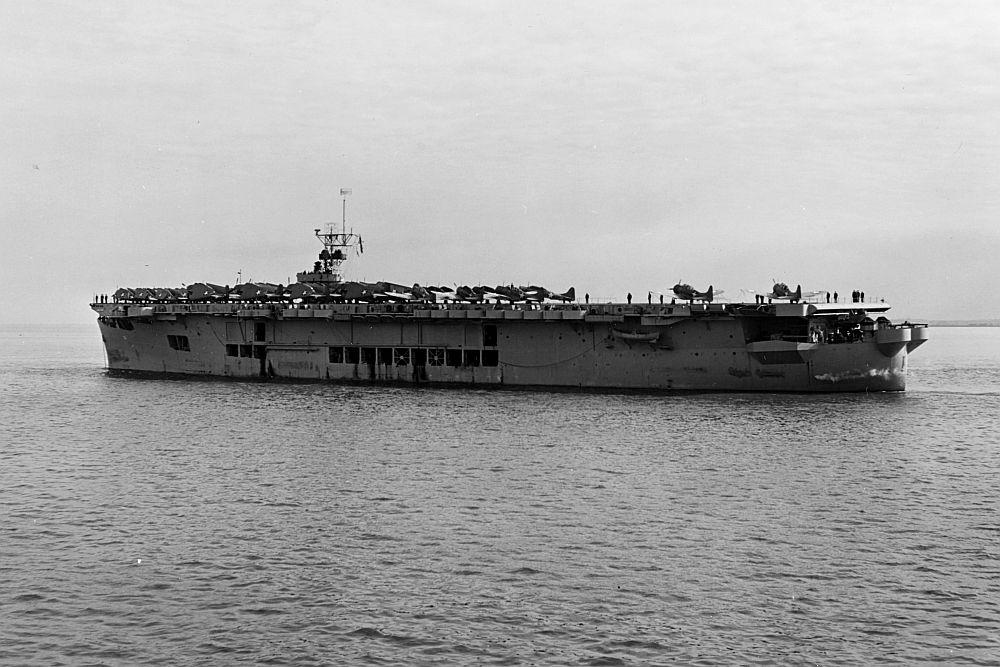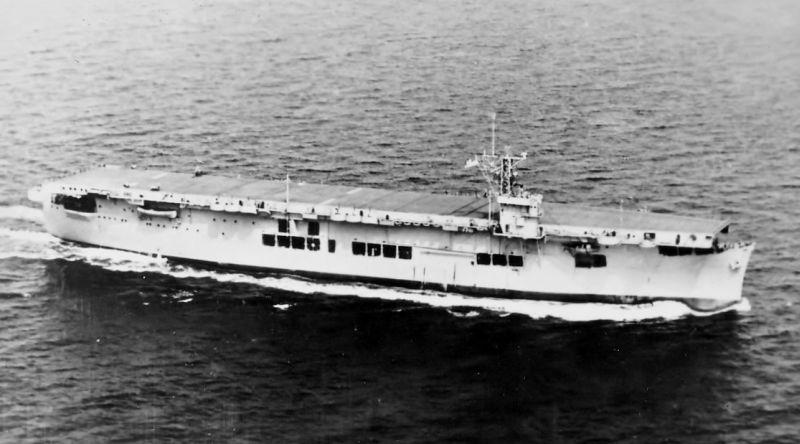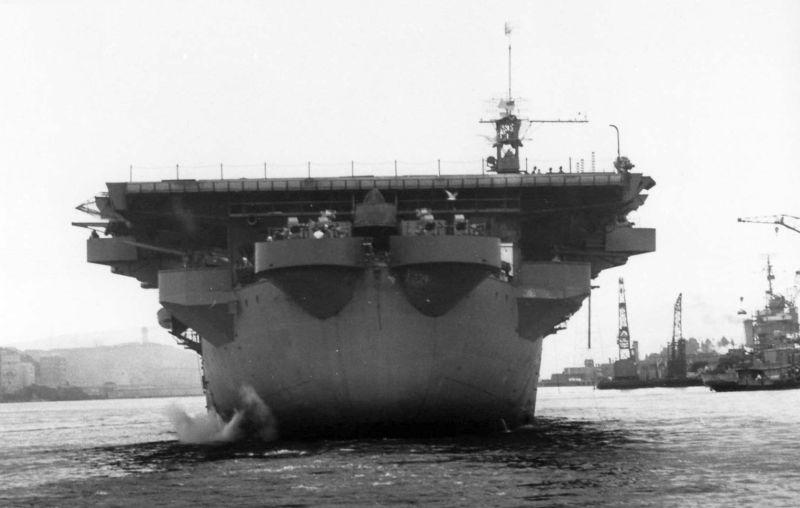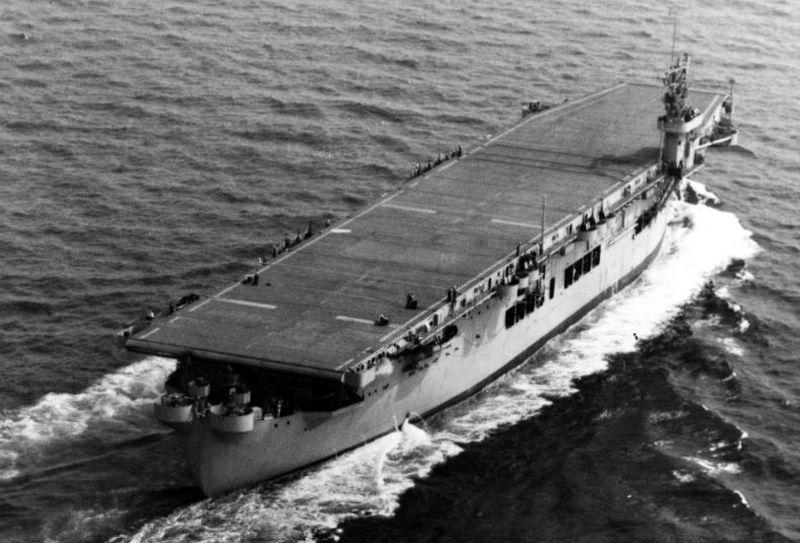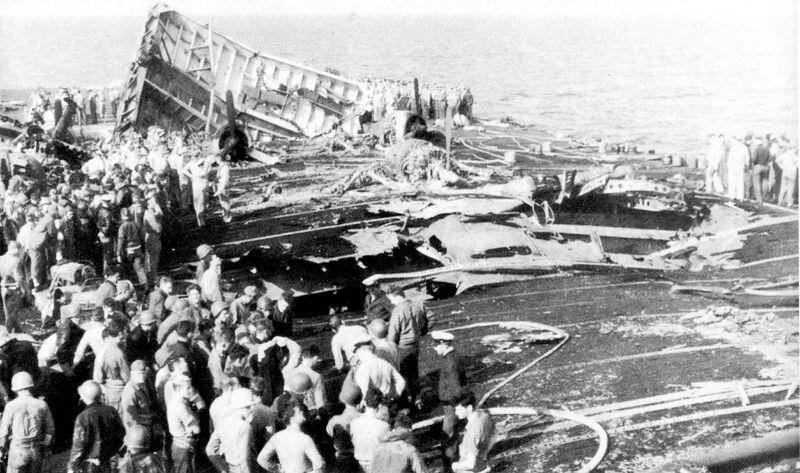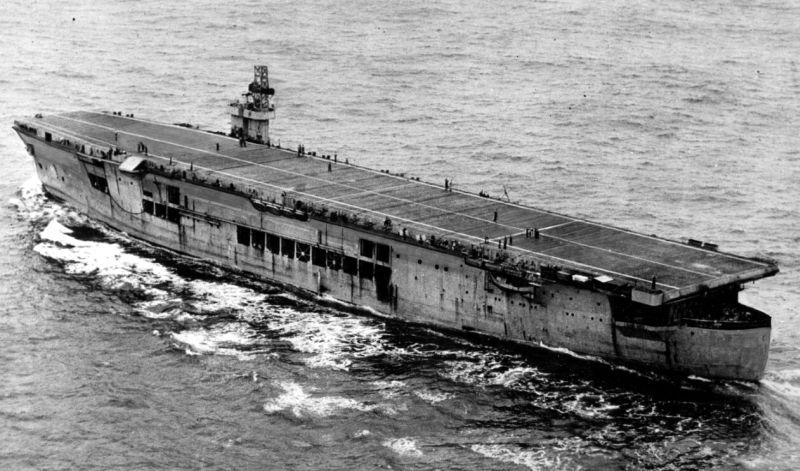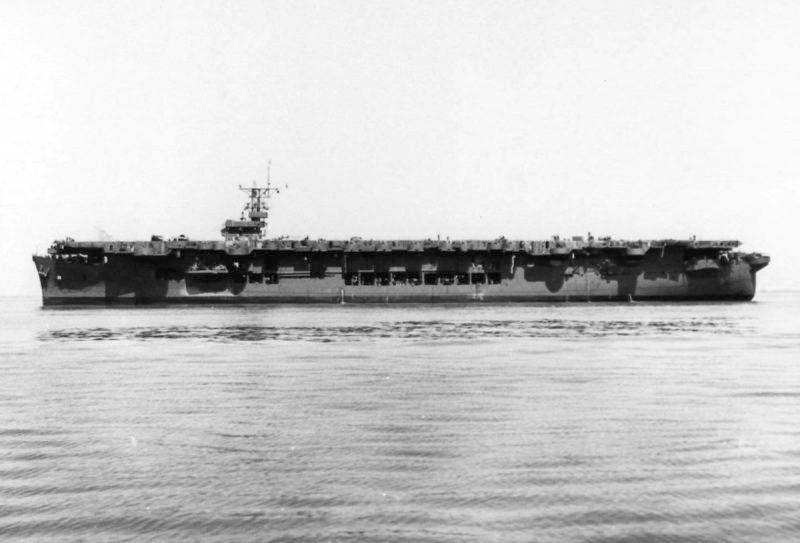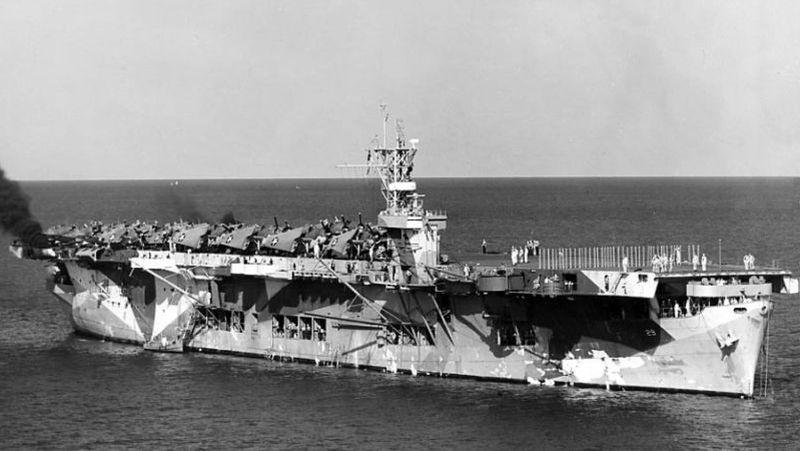Introduction
This article presents an overview of a particular class of US Navy escort aircraft carriers, introduced around the time the USA joined World War 2. The Sangamon class consisted of 4 vessels, commissioned in 1942 and converted from fleet oilers that had been requisitioned by the US government in 1940-1941 from civilian oil transport companies. Their original design as an oil tanker provided a rather perfect fit for a quick conversion into an auxiliary aircraft carrier. The Sangamon class was the only class of escort carriers converted from oil tankers. However, it provided a blueprint for a much larger number of newly constructed escort carriers in the course of WW2.
Ships of this class
| USS Sangamon
(CVE-26) |
Esso Trenton:
original name 13 maart 1939: keel laid 4 november 1939: launched 25 augustus 1942: commissioned |
| USS Suwannee
(CVE-27) |
Markay: original
name 3 juni 1938: keel laid 4 maart 1939: launched 24 september 1942: commissioned |
| USS Chenango
(CVE-28) |
Esso New Orleans:
original name 10 juli 1938: keel laid 1 april 1939: launched 19 september 1942: commissioned |
| USS Santee (CVE-29) |
Esso Seakay:
original name 31 mei 1938: keel laid 4 maart 1939: launched 24 augustus 1942: commissioned |
History
By early 1942, the American escort aircraft carrier program was in full swing, and all Type C3 merchant vessel hulls were soon discussed for conversion. To meet the high demand for escort aircraft carriers, the Secretary of the Navy ordered four tanker oilers to be converted into auxiliary aircraft carriers. The US Navy itself was not happy with this because the twin-screw tankers were very suitable for long-range operations in the Atlantic Ocean and the Pacific. However, the hulls of the tankers, built according to the T3 merchant tanker type, turned out to be very suitable as a basis for an aircraft carrier. They were longer than the C3-derived vessel and could therefore be equipped with a larger flight deck and a larger hangar. The compartmentalisation was also much better and the many fuel tanks could serve well as ballast and trim tanks, so that dumping permanent ballast was not necessary. The bunker space was eighty percent larger than that of a C3, allowing the ships to sail around the world at fifteen knots without refuelling. The generous fuel capacity could of course also be used to refuel the always fuel-thirsty escort destroyers.
The four converted tankers constituted the Sangamon-class escort aircraft carriers USS Sangamon, USS Suwannee, USS Chenango and USS Santee. As the war progressed, no more T3-type tankers were converted into escort aircraft carriers. However, as the Sangamon-class ships performed so well, their design was used as the blueprint for subsequent classes of auxiliary aircraft carriers. The Sangamon-class escort aircraft carriers themselves continued to be upgraded during World War II, receiving a second catapult, improved electrical systems and a much heavier anti-aircraft battery. This allowed the Sangamon escort carriers to accommodate almost as many aircraft as the Independence-class aircraft carriers.
Technical specifications
| Shipyard (Sangamon, Suwannee): | Federal Shipbuilding and Drydock Co. in Kearny, New Jersey |
| Shipyard (Chenango, Santee): | Sun Shipbuilding & Drydock Co. in Chester, Pennsylvania |
| Overall length: | 168.7 meter |
| Flight deck: | 153.1 x 25.9 meter |
| Extreme width: | 22.9 meter |
| Draft: | 9.86 meter |
| Displacement (standard): | 11,400 tons |
| Displacement (full load): | 24,665 tons |
| Installed Power: | 2 x geared steam turbines and 4 x boilers |
| Power output: | 13,500 shp |
| Shaft propellers: | 2 |
| Bunkerage: | 5,850 tons fuel oil |
| Maximum speed: | 18 knots |
| Complement: | 830 to 1080 officers and men including aircrew |
| Armament: | 2 x 13cm guns, 4 x 2 40mm and 12 x 20mm anti-aircraft machine guns |
| Armour: | None |
| Aviation facilities: | 2 x centre-lined hydraulic elevators, 1 x hydraulic catapult, 9 x arrestor cables |
| Aircraft: | 25 to 32 Grumman F4F Wildcat fighters, Grumman TBF Avenger torpedo bomber and SBD Dauntless dive bombers |
Definitielijst
- torpedo
- A weapon of war. A cigar shaped body fitted with explosives and a propulsion and control mechanism. Intended to target after launch a nearby enemy ship and disable it by underwater explosion.
USS Sangamon
The civilian tanker Esso Trenton was requisitioned by the US Navy on October 22, 1940, and commissioned a day later as AO-28. The oiler was subsequently assigned to the US Atlantic Fleet. At the beginning of 1942, the ship was designated for conversion into an auxiliary aircraft carrier. On February 25, the AO-28 was decommissioned and converted at the Norfolk Navy Yard. The ship received a flight deck of 153 meters long and 25.9 meters wide, two hydraulic aircraft elevators, a hangar deck, a hydraulic catapult, sonar equipment, aircraft workshops and warehouses for aircraft spare parts. Furthermore, the vessel received extensive accommodation facilities for the much larger crew and the airwing. Also, the ship was armed with cannons and anti-aircraft guns. On August 25, 1942, the new auxiliary aircraft carrier was commissioned as USS Sangamon and was designated ACV-26.
During the fall of 1942, USS Sangamon took part in Operation Torch, the Allied invasion of French North Africa. After a maintenance period, the aircraft carrier left for the Pacific in early 1943 to escort convoys to Guadalcanal. On July 15, 1943, USS Sangamon was designated CVE-26. In September 1943, during a scheduled maintenance, the escort aircraft carrier was provided with a modern combat centre after which the ship returned to continue her escort duties in the Pacific.
On January 25, 1944, a returning fighter plane crashed on the flight deck of USS Sangamon, causing a major fire. Several aircraft on the flight deck also caught fire and a number of explosions followed. The fire was quickly brought under control, but seven people were killed and seven injured. Furthermore, fifteen crew members had jumped overboard to escape the flames, but only thirteen were found and rescued. After the necessary repairs, USS Sangamon assisted in the amphibious landings in the Marshall Islands.
From November 30, 1944, to January 24, 1945, the USS Sangamon was under maintenance at the Navy Yard in Bremerton, Washington. During this period the escort aircraft carrier received new ammunition stores, a second hydraulic catapult, new radar equipment, new 40mm gun emplacements, a bomb elevator and additional firefighting equipment.
On May 4, 1945, the Sangamon was hit by a kamikaze near Okinawa. Both the bomb and parts of the suicide pilot's plane penetrated the unarmoured flight deck, causing extensive damage to the hangar. A fire erupted and explosions took place. The fire soon spread to the flight deck and communication with the bridge was soon no longer possible. The crew of the escort aircraft carrier battled the fire with water and carbon dioxide cartridges, assisted by escort ships. By evening the fires were under control and USS Sangamon was able to sail under its own power to Pearl Harbor for emergency repairs. Eleven people were killed, 21 seriously injured and 25 crew members were missing. On June 12, the vessel arrived in Norfolk, Virginia, but full repair was suspended because the Japanese capitulated on August 15. USS Sangamon was awarded eight Battle Stars for her actions during World War II.
On October 24, 1945, USS Sangamon was decommissioned and removed from the Naval Vessel Register a week later. The ship was converted into a tanker and sold to the Hillcone Steamship Co. in San Francisco. The vessel was handed over on February 11, 1948. Thereafter, several successive transfers took place: in July 1952 to the World Commerce Corp. in New York; on January 23, 1958, to the Maritime Transportation Co. from Panama; on April 5, 1960, to Sangamon Corp. in Monrovia, Liberia. On March 9, 1960, the tanker left Galveston, Texas, bound for Bombay, India. However, the ship ran aground and was towed to Suez. In August 1960 the tanker was scrapped in Osaka, Japan.
Definitielijst
- invasion
- Armed incursion.
- kamikaze
- “Divine Wind”. A kamikaze pilot would fly himself, his airplane and bomb(s) literally into an enemy target, preferably a US ships. This was a noble cause, considered a most honourable death for the emperor. Several thousands of kamikaze pilots died this way.
- radar
- English abbreviation meaning: Radio Detection And Ranging. System to detect the presence, distance, speed and direction of an object, such as ships and airplanes, using electromagnetic waves.
USS Suwannee
The tanker Markay was owned by the Keystone Tankship Corporation until it was requisitioned by the US government on June 26, 1941, and commissioned into service with the US Atlantic Fleet on July 16 as tanker oiler AO-33. After six months, on February 14, 1942, the tanker was decommissioned and transferred to the Newport News Shipbuilding & Drydock Co. at Newport News, Virginia, for conversion into a Sangamon class auxiliary aircraft carrier. On September 24, 1942, the ship was commissioned as USS Suwannee AVG-27. The crew of the escort aircraft carrier was only given a very short training period because on November 8, 1942, the Suwannee was already assigned to Operation Torch. The auxiliary aircraft carrier then performed escort duties in the Pacific for more than seven months. On July 15, 1943, USS Suwannee was designated CVE-27.
During the remainder of World War II, USS Suwannee participated in the invasions of the Gilbert and Marshall Islands, New Guinea, and the Mariana Islands. In mid-October 1944, the escort carrier took part in the Battle of Leyte Gulf, the largest naval battle of the Second World War. On October 25, USS Suwannee was hit by a Kamikaze after the ship's anti-aircraft defences had prevented two suicide attacks by other Japanese pilots. The Japanese aircraft almost struck the carrier on the aft carrier elevator, but the bomb it was carrying penetrated the flight deck and exploded on the hangar deck. This action resulted in several deaths, but the damage was quickly repaired so that the Suwannee could remain operational. A second Kamikaze crashed onto the flight deck several hours later, on top of a torpedo bomber that had just landed on deck. This caused fierce fires that raged for hours, and the Suwannee had to withdraw from the battle. A total of 107 people were killed and 160 injured on board.
After emergency repairs, USS Suwannee was able to sail under its own power to the Puget Sound Navy Yard in Bremerton, Washington, for permanent repairs. The ship was ready just in time to take part in the invasion of Okinawa. The aircraft carrier was later involved in landings on Borneo. After the Japanese capitulation, the vessel was part of the occupying force of Japan for some time. USS Suwannee earned thirteen Battle Stars for her actions during World War II.
On October 28, 1946, USS Suwannee was assigned reserve status as part of the 16th Fleet at Boston, Massachusetts. The ship was decommissioned on January 8, 1947, and spend years in the mothballed fleet in Boston. On June 12, 1955, the ship was re-designated as a helicopter carrier with name signal CVHE-27 but remained assigned to the reserve fleet. On May 1, 1959, the vessel was removed from the Naval Vessel Register and sold to the Isbrantsen Steamship Company of New York. The ship was to be converted into a tanker, but this ultimately fell through. In May 1961, the discarded ship was sold to the J.C. Berkwit Company, New York. The hull was scrapped in Bilbao, Spain, from June 1962.
Definitielijst
- capitulation
- Agreement between fighting parties concerning the surrender of a country or an army.
- invasion
- Armed incursion.
- Kamikaze
- “Divine Wind”. A kamikaze pilot would fly himself, his airplane and bomb(s) literally into an enemy target, preferably a US ships. This was a noble cause, considered a most honourable death for the emperor. Several thousands of kamikaze pilots died this way.
- mid
- Military intelligence service.
- torpedo
- A weapon of war. A cigar shaped body fitted with explosives and a propulsion and control mechanism. Intended to target after launch a nearby enemy ship and disable it by underwater explosion.
USS Chenango
The Chenango was built as Esso New Orleans by the Sun Shipbuilding & Dry Dock Co. in Chester, Pennsylvania. The tanker was requisitioned by the government on May 31, 1941, and commissioned on June 20 as tanker oiler AO-31. On March 16, 1942, the ship was decommissioned and transferred to the Bethlehem Steel Co. at Staten Island, New York, for conversion into an auxiliary aircraft carrier. On September 19, 1942, the vessel was commissioned as such and given the name USS Chenango with designation ACV-28. Immediately after her seat trials, the auxiliary aircraft carrier was assigned to Operation Torch. On November 13, the ship delivered oil to 21 destroyers at Casablanca before sailing for Norfolk, Virginia. From January 1943, the Chenango was assigned to the US Pacific Fleet and provided support for the invasion and occupation of the Solomon Islands.
Like the other American auxiliary aircraft carriers, USS Chenango was classified as an escort aircraft carrier on July 15, 1943, and designated CVE-28. After a maintenance period, the Chenango served as a training ship for new flying wings from August to October 1943. Later in 1943 and 1944 the escort aircraft carrier provided air cover for the invasions of the Gilbert and Marshall Islands and the Philippines. In October 1944, USS Chenango was part of the American fleet during the Battle of Leyte Gulf. In February 1945 the ship was due for maintenance again and returned to the Solomon Islands in March. During the summer of 1945, the Chenango was involved in the invasion of Okinawa. The United States government awarded USS Chenango eleven Battle Stars for her contributions during World War II.
On August 14, 1946, the Chenango was taken out of service and taken into reserve in Boston. On June 12, 1955, the escort aircraft carrier was re-classified as a helicopter carrier with name signal CVHE-28 but remained in reserve. On March 1, 1959, the Chenango was struck from the US Naval Vessel Register. The ship was then sold for demolition and scrapped in Spain in 1962.
Definitielijst
- invasion
- Armed incursion.
USS Santee
The T3 tanker Esso Seakay was requisitioned by the US government on October 18, 1940, and converted into an auxiliary aircraft carrier at the Norfolk Navy Yard in Norfolk, Virginia. On August 24, 1942, the new aircraft carrier was commissioned as USS Santee and designated ACV-29. Like her sister ships, the Santee was assigned to Operation Torch immediately after her sea trials. Her aircraft provided air cover for the amphibious landings of French North Africa and destroyers could load oil from her large supplies. In 1943, the USS Santee was primarily an escort carrier, and its aircraft protected convoys and tracked submarines. On July 15, 1943, the Santee officially became an escort carrier with name signal CVE-29. In late 1943, the vessel brought a flight deck full of Lockheed P-38 Lightning fighter aircraft from Staten Island to Glasgow, Scotland.
In early 1944, USS Santee continued to serve for a while as an aircraft transport ship, bringing fighter aircraft, among others, from San Diego, California, to Pearl Harbor. From the spring of 1944 on wards, the escort carrier was mainly active in the Pacific. The ship supported landings in New Guinea, the Solomon Islands, the Admiralties and the Dutch East Indies. On October 25, 1944, during the Battle of Leyte Gulf, USS Santee suffered both a Kamikaze hit and a torpedo hit from a Japanese submarine. Although several fires broke out and a few compartments became fully flooded, the ship remained afloat. After the battle, despite a six-degree list, the Santee was able to sail under its own power to Pearl Harbor for temporary repairs. Final repairs took place in San Diego.
In March 1945, USS Santee was back in action in the Philippines and later in the invasion of Okinawa and the attack on Kyushu, Japan. On July 7, a Santee aircraft crashed on its flight deck and ended up between parked aircraft. Four fighter planes and two torpedo bombers caught fire. The fire was quickly subdued, but most of the escort carrier's aircraft was disabled. The Santee was directed to Guam for repairs. Shortly after Japan's capitulation, the aircraft carrier brought prisoners of war from Formosa, now Taiwan, to Manila Bay. USS Santee was awarded nine Battle Stars for her actions during World War II.
On March 25, 1946, the Santee arrived in Boston, Massachusetts, where the ship was prepared to become part of the reserve fleet. On October 21, the conservation work was completed and she was subsequently mothballed. On June 12, 1955, the Santee was classified as helicopter carrier CVHE-29 while remaining in reserve. Nearly four years later, on March 1, 1959, the Santee was removed from the Naval Vessel Register and sold for scrapping to Germany on December 5. The German ocean-going tug Seefalke towed the decommissioned ship to Bremerhaven where it was dismantled, along with the USS Coral Sea, a Casablanca-class escort carrier.
Definitielijst
- capitulation
- Agreement between fighting parties concerning the surrender of a country or an army.
- invasion
- Armed incursion.
- Kamikaze
- “Divine Wind”. A kamikaze pilot would fly himself, his airplane and bomb(s) literally into an enemy target, preferably a US ships. This was a noble cause, considered a most honourable death for the emperor. Several thousands of kamikaze pilots died this way.
- torpedo
- A weapon of war. A cigar shaped body fitted with explosives and a propulsion and control mechanism. Intended to target after launch a nearby enemy ship and disable it by underwater explosion.
Epilogue
The Sangamon-class escort aircraft carriers were the largest converted American aircraft carriers. Their tanker base made the ships excellent aircraft carriers but could still also function as fleet oilers. The Sangamon ships were the only class of escort aircraft carriers that could incorporate dive bombers into their air groups. In 1942, when the United States had just entered World War II, the US Navy had only a few aircraft carriers. The Essex-class fleet carriers and the Independence-class aircraft carrier-converted cruisers had yet to enter service. The US Navy was therefore in great need of carriers and ships like the Sangamon class filled the vacuum. Although the US Navy was initially not happy with the conversion of four excellent fleet oilers into auxiliary aircraft carriers, the Sangamon carriers performed with distinction. The four ships also proved to be able to take a beating because bombs, plane crashes, torpedoes and Kamikazes could not sink them. Collectively, the four Sangamon-class ships earned a whopping 41 Battle Stars.
After the Sangamon class, the conversion of Maritime Commission T3-type tankers was stopped because the US Navy did not want to sacrifice any more of them. However, due to surging demand a switch was made to build new escort carriers, whose design was based on the T3 tankers. These became the Commencement Bay class ships. Of these, 33 would be built, but only nineteen saw active service. Due to the end of the Second World War, the remainder were either not completed or even their keel was not laid.
At the same time as the Sangamon-class escort aircraft carriers became operational, the American auxiliary aircraft carriers of the Bogue class entered service. These were converted C3 merchant ships. A total of 45 were built of which 34 were transferred to the Royal Navy and entered British service as the Attacker class and the Ameer class.
Information
- Article by:
- Peter Kimenai
- Translated by:
- Simon van der Meulen
- Published on:
- 19-01-2025
- Feedback?
- Send it!
Related books
Sources
- GREEN, M., Aircraft Carriers of the United States Navy, Pen & Sword Maritime, Barnsley, 2015.
- IRELAND, B., Vliegdekschepen, Veltman Uitgevers, Utrecht, 2007.
- LYON, H, Encyclopedie van de belangrijkste oorlogsschepen ter wereld, Scriptoria, Antwerpen, 1980.
- MCCURTIE, F.E., Jane`s Fighting Ships of World War II, Military Press, New York, 1989.
